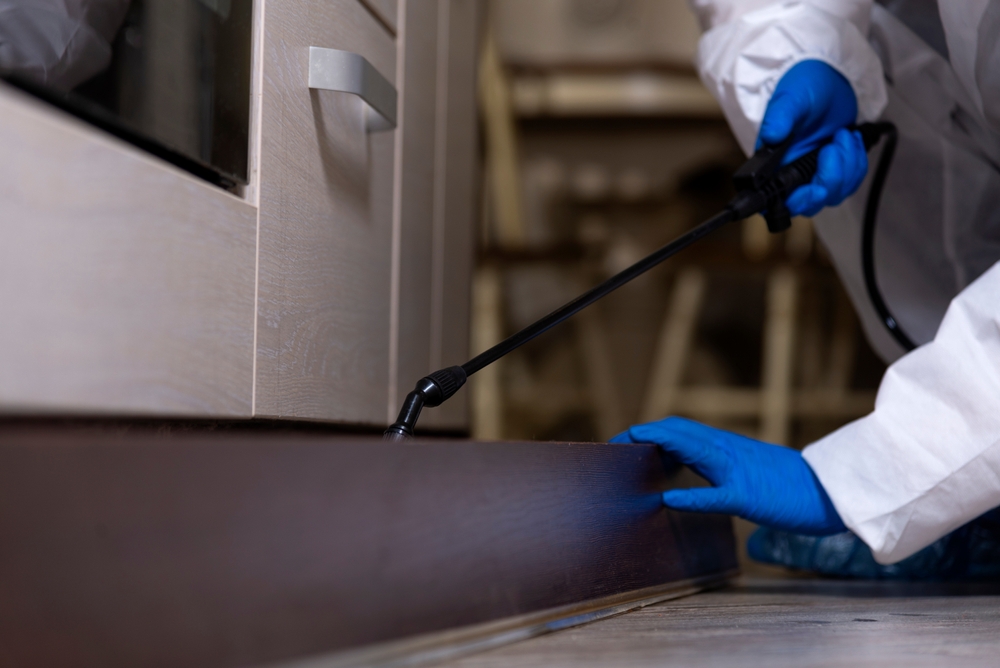Effective Extermination for Fleas: What You Need to Know
Facing a flea infestation? Learn effective extermination for fleas to reclaim your home.
- Early identification of flea infestations involves observing increased pet scratching, flea dirt, and itchy red spots on humans.
- Professional extermination is essential for severe infestations, employing a multi-step approach including inspection, targeted treatments, and source addressing for long-term results.
- Preventive measures like regular grooming, cleaning, and the use of veterinarian-approved treatments are crucial to avoid future flea infestations.
Identifying a Flea Infestation
Early recognition of a flea infestation helps prevent it from spiraling out of control. One of the first signs is increased scratching and restlessness in your pets. Specks of flea dirt—essentially flea feces—on surfaces like pet bedding, carpets, and furniture are another telltale sign. If you or your family members start noticing itchy red spots, particularly around the lower legs, it’s a clear indication that cat fleas have invaded your space.
Flea eggs, which look like tiny white grains, can often be found in pet bedding and carpets. These eggs hatch into larvae, which burrow into carpets and hidden corners, making them difficult to spot and eradicate. Prompt action on these eggs is necessary, as untreated eggs can rapidly spread throughout your home.
Understanding the flea life cycle is vital for effective eradication. Fleas go through several stages: eggs, larvae, pupae, and adult fleas. Identifying and controlling fleas early can prevent a major infestation.
Professional Flea Extermination Process
When faced with a rapid flea population growth, professional intervention becomes necessary. Exterminators have the expertise required to manage complex flea infestations effectively and safely. Specialist consultation is necessary due to health risks like flea bites and disease transmission.
Professional flea extermination follows several key steps for complete eradication. It typically starts with inspection and assessment, followed by targeted treatments, and concludes by addressing the infestation source for long-term results, often requiring the expertise of a flea exterminator.
Inspection and Assessment
Effective flea control starts with a thorough inspection. Exterminators will inspect areas where pets sleep, such as pet beds and bedding, carpets, rugs, and dark places where fleas might hide. They also check upholstery, cracks, crevices, and outdoor areas where pets might roam.
Professionals look for flea dirt and identify all life cycle stages, including eggs, larvae, pupae, and adult fleas, during the inspection. Flea eggs and larvae hide in hard-to-reach spots like cracks or dark crevices, making a thorough inspection essential.
Vacuuming or laundering pet resting areas is crucial for effective flea control. This helps to remove flea eggs and reduce the flea population before treatment begins.
Treatment Methods
Once the inspection is complete, the next step is treatment. Professional exterminators use a variety of chemical treatments, including sprays, foggers, and insect growth regulators (IGRs), that effectively target fleas. IGRs inhibit the maturation of flea larvae into adult fleas, providing an essential non-chemical approach to treatment.
Multiple treatment strategies are essential to eradicate fleas and target all life stages. Exterminators employ advanced equipment for flea control that is typically unavailable to the public, enhancing the effectiveness of treatments.
Initial combined treatments significantly reduce flea populations and prevent future infestations. This approach addresses all flea life stages, ensuring long-term relief from these pests.
Addressing the Source
Addressing the infestation source is necessary for lasting results. Treating pets with veterinarian-approved products like Frontline Plus is necessary. Regular washing of pet bedding supports extermination and prevents re-infestation.
Homeowners should also prepare for treatment by laundering pet bedding and vacuuming thoroughly. Vacuum bags should be discarded outside of the home after each use to prevent re-infestation.
Directly targeting the flea source, treating pets and bedding, and preparing the home significantly reduces the chances of re-infestation. This comprehensive approach is crucial for long-term flea control.
What to Expect During Professional Flea Treatment
Preparation of the home is crucial for successful flea treatment. Laundering pet bedding and thoroughly vacuuming helps remove fleas and eggs before treatment. Moving furniture and clearing clutter allow exterminators to access all necessary areas.
Exterminators follow a multi-step approach of inspection, treatment, and follow-up for complete flea elimination. Homeowners and pets must leave the home for several hours to ensure safety during chemical treatments. Temporary absence helps avoid chemical exposure.
After treatment, homeowners should wait at least four hours before re-entering the treated space to ensure safety. Reporting any signs of flea activity helps in scheduling potential re-treatment. Understanding what to expect helps homeowners prepare and ensures effective treatment.
Post-Treatment Expectations
An immediate reduction in adult fleas is expected after initial treatment to kill adult fleas. More fleas may appear within 7 to 14 days as eggs hatch and develop. This is natural, and gradual elimination will occur over 21 to 28 days.
Daily vacuuming during the 21 days post-treatment stimulates flea egg hatching and enhances effectiveness. Regular vacuuming removes newly hatched fleas and reduces the population.
Monitoring hidden areas like carpets and pet bedding ensures complete eradication. Frequent vacuuming maintains a clean environment and minimizes re-infestation chances.
Follow-Up Visits and Monitoring
Follow-up visits ensure complete eradication and prevent re-infestation. Exterminators re-treat and check for remaining fleas during follow-up visits. These visits ensure remaining fleas are eliminated, keeping the home flea-free.
Regular checks for signs of fleas on pets and living areas are recommended post-treatment. Contact an expert immediately if flea bites cause discomfort or signs of fleas persist despite treatment.
Vigilance and scheduled follow-up visits ensure complete resolution and prevent future infestations.
Preventive Measures for Pet Owners
Future flea infestations can be prevented through regular grooming, cleaning, and veterinarian-approved treatments. Regular grooming helps remove fleas and eggs, reducing their population. Regular vacuuming maintains a clean environment and reduces re-infestation chances.
Non-chemical methods like vacuuming and steam cleaning support chemical treatments by eliminating eggs and larvae. These methods effectively reduce flea populations and prevent future infestations.
Veterinarian-approved flea treatments are recommended as part of a comprehensive flea control products strategy. Effective flea control and prevention require targeting the infestation source. Following these preventive measures helps keep homes flea-free and ensures pet health and comfort.
When to Call a Professional
Call in professionals when over-the-counter products fail to resolve a flea infestation. Consider hiring a pest control professional when vacuuming and laundering efforts fail. Professional exterminators offer specialized treatments and expertise for effective flea control.
Dealing with a flea infestation requires a comprehensive approach that includes identifying the problem, professional extermination, post-treatment care, and preventive measures. By understanding the signs of a flea infestation and knowing when to call in the professionals, homeowners can effectively control and eliminate fleas from their homes.
Don’t let fleas take over your home—reach out to a professional for effective flea control and peace of mind.
Frequently Asked Questions
What are the signs of a flea infestation?
Signs of a flea infestation include increased scratching in pets, itchy red spots on human skin, and the presence of tiny specks of flea dirt on surfaces. Immediate action is recommended if you notice these symptoms.
How long does it take to see results after professional flea treatment?
You can expect to see immediate results in terms of reduced adult fleas, with a complete elimination occurring within 21 to 28 days after professional flea treatment.
What should homeowners do to prepare for professional flea treatment?
To effectively prepare for professional flea treatment, homeowners should launder pet bedding, vacuum thoroughly, and clear rooms by moving furniture and removing clutter. This preparation helps ensure the treatment is successful and lasts longer.
Why are follow-up visits important after flea treatment?
Follow-up visits are essential to confirm the complete elimination of fleas and to prevent any potential re-infestation. Consistent monitoring helps maintain a pest-free environment.
What preventive measures can pet owners take to avoid future flea infestations?
To avoid future flea infestations, regularly groom your pet, use veterinarian-approved treatments, and maintain a clean environment by vacuuming frequently. Taking these steps will help keep your furry friend protected.





